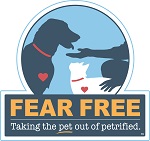Separation anxiety is defined as anxiety, stress and/or fear (sometimes mild, sometimes severe) that your dog experiences when left alone. This may present as howling or barking, urinating or defecating, destructive behavior, pacing or trying to escape a crate or even the house when your dog has been left alone.
It is anticipated that some dogs who have not previously suffered from separation anxiety may start to develop it when owners who have been working from home due to COVID 19 start returning to work.
There is no one reason why dogs develop separation anxiety, but it is more prevalent in dogs adopted from shelters or rescues. This makes sense as changes in homes. guardians or schedules are known triggers for the development of separation anxiety. Things thought to contribute to separation anxiety include:
- Change of owner or changes in family members (new family members or family members leaving)
- Abrupt or significant change in schedule
- Change of residence/home/moving
- Loss of a companion animal (another pet that dog is close to dies or is rehomed leaving the remaining pet alone)
- Being surrendered to a shelter
- Being boarded at a kennel or someone else’s home (someone unfamiliar or an unfamiliar home)
All of these things can cause anxiety and a fear of being left alone. Separation anxiety is most easily treated in it’s early stages before it gets worse. Early intervention and proper counter conditioning is usually necessary to keep mild separation anxiety from progressing from mild to severe. Many times it can be a huge advantage to get help from an animal behaviorist right from the start to prevent things from getting worse. Once separation anxiety becomes severe it is much more difficult to treat. There is a lot of good information online (check out ASPCA’s article on separation anxiety) or helpful books on the subject. We recommend the book “I’ll be home soon” by Patricia McConnell and have copies available for purchase at the clinic.
For mild cases of separation anxiety, the goal is to change the perception in the dog’s mind of you leaving from a “bad” thing to a “good” thing or at least not a big deal. To change the dog’s perception you must look at triggers for the anxiety (picking up your keys, getting on your coat, etc.) and try to change the perception from the dog’s point of vies. This is partially done by counter conditioning to the stimulus – picking up the keys and putting them down throughout the day, or taking your coat on and off at random times, to make these things more meaningless to the dog. The other component is to make the dog look forward to good things happening when you leave. This can be achieved with food motivated dogs by using high value treats/rewards when you leave.
This is more likely to be effective if you:
- Use puzzles, tricky treat balls or stuffed kong toys to make the treat last for at least 15-20 minutes or so after you leave. Treats should be “high value” and something the dog only gets when you leave – no other time. Freezing things in a kong or similar toy can help them to last longer. You can freeze things like low fat cream cheese, canned dog food, baby food, cottage cheese or yogurt, low fat peanut butter or spray cheese. Make sure it isn’t something that is going to upset your dog’s digestive tract.
- Prepare these special treats a little bit before you leave and put them out where the dog can see them. Your goal is to have the dog want you to leave so they can have the yummy treats. You want them to start making an association with these special treats with you leaving, therefore changing their perception of you leaving from a “bad” thing to a “good” thing.
- Teaching your dog to sit and stay while you hide treats around the house can work for some dogs. Work on the concept of sit and stay until you give the okay. Your dog needs to understand that treats are hidden to find. This keeps them busy and the mind occupied and helps to redirect their focus to finding treats instead of being anxious that you are leaving.
The things listed above are only a small part of the equation. Separation anxiety can be challenging and takes a lot of time, dedication, consistency and effort from everyone in the household. Working with a behaviorist to make sure you are doing the steps properly can go a long way to helping a dog with separation anxiety. In some cases anti-anxiety medications can be used in conjunction with counter-conditioning/behavior modification, however these should not be used as the only thing done to solve the problem. Medications should be used as a bridge or an aid while doing the rest to help the dog make progress easier and to help them get past the anxiety easier while learning new ways to cope. Medications alone without behavior modification should never be the entire answer.
Separation anxiety can be a complicated, frustrating and difficult issue to resolve. Trying to understand things from your dog’s point of view and getting expert help are two things that can be very helpful in dealing with this complex issue.




